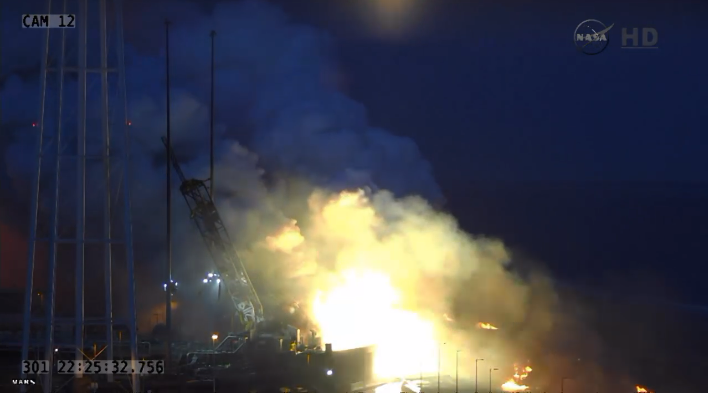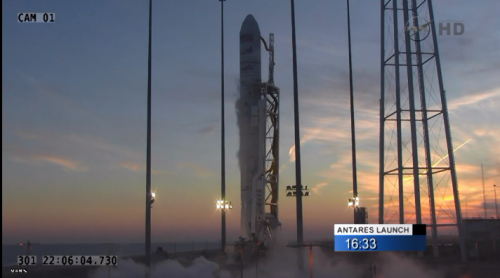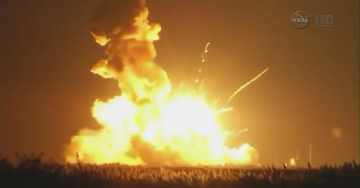
Following a frustrating 24-hour delay, caused by the presence of an unauthorized watercraft in the Launch Danger Zone, the heart was torn from Orbital Sciences Corp. today (Tuesday, 28 October), following the explosion—just six seconds after liftoff at 6:22 p.m. EDT—of its fifth Antares booster from Pad 0A at the Mid-Atlantic Regional Spaceport (MARS) on Wallops Island, Va. A gorgeous sunset, near-perfect weather conditions, and an exceptionally smooth countdown might have seemed the ideal prelude for a successful flight of the third dedicated Cygnus cargo mission (ORB-3) to the International Space Station (ISS). That success has now been shattered and Antares indefinitely grounded as Orbital seeks to understand what caused its largest home-grown cryogenic rocket to vanish in a ball of fire.
As noted in AmericaSpace’s ORB-3 preview article, the launch was originally targeted to occur yesterday (Monday, 27 October). In anticipation of this opening attempt, Antares—which stands 133 feet (40.5 meters) tall and represents Orbital’s largest home-grown cryogenic launch vehicle—was rolled horizontally from the Horizontal Integration Facility (HIF) to Pad 0A late last week, then raised to the vertical by means of its Transporter-Erector-Launcher (TEL) gantry. The Antares/Cygnus flight control teams received their formal “Call to Stations” at about 3 p.m. EDT Monday, a little under four hours before the targeted T-0, which was timed to occur at precisely 6:45:00 p.m. About 45 minutes after the Call to Stations, the process of “chilling down” the fuel lines of the rocket’s first stage with liquid nitrogen got underway, prior to the loading of cryogenic propellants. This chill-down protocol serves to avoid catastrophically shocking the hardware by being suddenly hit by a rapid temperature differential.
During this period, the precise T-0 time for Monday was refined to occur at 6:44:03 p.m., to create the most optimum conditions for orbital insertion and setting the Cygnus cargo ship up for its extended five-day rendezvous profile to reach the ISS. With weather conditions along the Virginia coast described as “near-perfect,” the sole obstacle arose shortly after 5 p.m., when it became clear that an unauthorized watercraft had been detected in the launch danger area. This apparent violation occurred in spite of a clear Notice to Airmen and Mariners (NOTAM) warning, which had been put in place to cover the period from 27-31 October inclusive. Ironically, Monday evening’s delay would be caused by a violation of the NOTAM itself.

Unauthorized boats and even aircraft intruding into the launch danger area are nothing new for space missions, and although the Range Safety Officer (RSO) console was obliged to declare itself “Red” (“No-Go”) until the situation cleared, all other stations were “Green” (“Go”) and were ready to support the launch. With an expectation that the issue would clear up shortly, Orbital managers opted to proceed through its standard poll of all stations at T-90 minutes and press into the loading of propellants. Shortly after 5:30 p.m., the liquid oxygen began flowing into the tanks, then transitioned into “fast-fill” mode as the Sun went down in anticipation of the first Antares launch in the hours of darkness.
The propellant loading process is critically timed to begin about 90 minutes before liftoff, in order to satisfy temporal limits associated with the rapid boil-off of the cryogenics. During this period, the sole technical difficulty appeared to center on a ground-based purge system issue. A final poll took place in two stages—with the rogue boat still uncleared—and all controllers, save the RSO, declared themselves “Green.” It was clear that Orbital intended to utilize the entire 10-minute “window,” but no one knew how close to the wire Monday’s attempt would go. Fueling concluded a little before 6:30 p.m., at T-15 minutes, by which stage all propellants had reached “Flight Ready” levels. Standing tall and beautiful against the now-dark Wallops sky, Antares transitioned to internal power. The Flight Termination System (FTS)—which carries the responsibility of destroying the rocket in the event of a major accident during ascent—was placed onto internal power and armed, with the Cygnus cargo ship transferred to on-board battery power to sustain its systems until the deployment of its electricity-generating solar arrays in orbit.
At this stage, the near-perfect countdown hit its first major problem. It was later reported that the unauthorized boat could not be contacted, and the countdown was halted at T-12 minutes at just after 6:33 p.m. to await a firm Go/No-Go decision. With the window due to close at 6:55:04 p.m., it was critical that the clock be released no later than 6:43 p.m. Yet still there came no word from the boat, and the RSO’s status remained “Red.” At 6:42 p.m., a decision was made to push on with the countdown and the clock resumed ticking. At T-11 minutes, the TEL was armed to execute a rapid retraction from the vehicle at the instant of liftoff. However, a liftoff was to prove elusive for Orbital on Monday, for the situation could not be resolved in sufficient time and at 6:45 p.m. the attempt was scrubbed.

Unsurprisingly, as efforts to safe Antares got underway and the FTS was returned to external power and engineers set to work discharging the booster’s hydraulics, much frustration was directed toward the “operator” of the watercraft which had caused the issue. The NOTAM identified that the launch danger zone would be in effect from 6:30-8:00 p.m. Monday, 6:15-7:45 p.m. Tuesday, 5:45-7:15 p.m. Wednesday, 5:30-7:00 p.m. Thursday, and 5:00-6:30 p.m. Friday and clear guidance was provided for the safety of all pilots and mariners. “The Army Corps of Engineers Danger Zone will be in effect for all launch attempts per 33 Code of Federal Regulations Part 334,” NASA explained. “Fines and arrest authority are permissible by U.S. Coast Guard and Virginia Marine Police.”
Orbital teams immediately recycled to prepare for a second launch attempt at 6:22 p.m. Tuesday, 28 October, and formal countdown operations got underway late this morning. Weather conditions were classified as 95 percent favorable as the Sun set at 6:03 p.m., and all stations declared their readiness to support the launch, with the temporary exception of the RSO console, which required some additional time to relocate NASA personnel from Assateague Island. All propellant tanks were declared at Flight Ready levels, the FTS was again placed onto internal power and armed—with voltages and currents declared as nominal—and the Cygnus spacecraft was again transitioned to battery power for its ride into orbit. Final weather balloon data confirmed that all necessary criteria had been met, and by 6:07 p.m. the RSO console declared itself “Green.”
A growing tradition for each Cygnus flight has been to provide it with a name, honoring an individual who has contributed to the goals of Orbital itself or more broadly to the commercial space exploration agenda. The ORB-D “Demonstration” flight in September 2013 was named in tribute of veteran shuttle astronaut and senior Orbital executive G. David Low, whilst ORB-1 in January 2014 bore the name of former shuttle commander C. Gordon Fullerton and ORB-2 in July 2014 honored five-time space flyer Janice Voss. Continuing the tradition, the ORB-3 mission paid homage to Deke Slayton, one of the “Original Seven” NASA astronauts, grounded from his Mercury flight by a heart murmur in 1962 and for many years a guiding light in the drive to plant human bootprints on the Moon, before eventually reaching space aboard the Apollo-Soyuz Test Project (ASTP) mission in July 1975. Offering their own nod of respect to Slayton, Orbital’s flight control team donned 1960s-era “retro”-style shirts and skinny ties for both launch attempts. Images and a cardboard cut-out of Slayton were also displayed with pride throughout the control room.

With ORB-3 “Spaceship Deke Slayton” thus transitioned to internal power, the TEL was armed to execute its rapid retraction, and at 6:11 p.m. a final poll of all stations produced a unanimous “Go for Launch.” The final minutes were punctuated by a rather noisy period of nitrogen purging from the vehicle, ahead of the onset of the “Terminal Count” at T-3 minutes and 30 seconds. “Range Green” came the encouraging final status call, amid a forest of “Go” calls. Shortly thereafter, Antares’ autosequencer assumed primary command of all critical functions, controlling all events up to the ignition of the twin AJ-26 engines of the first stage at T-0. Under careful computer control, the engines—which are derived from Soviet-era NK-33 powerplants, once intended for use aboard the N-1 lunar superbooster—roared to life and spent two seconds ramping up to full power, before Antares left Pad 0A at 6:22 p.m.
What happened next was the stuff of horror movies. Ascending in a blaze of golden light into the black sky, this was the first Antares to launch in the hours of darkness. Yet within six seconds of leaving Earth, the booster burst into flames, showering burning debris across Pad 0A. According to AmericaSpace’s Launch Tracker, the pitch and roll program maneuver had taken place and the anomaly occurred just a few hundred yards from the pad. Within minutes, the announcement came from officials at MARS that there was “no indication that personnel are in danger, although significant property damage and significant vehicle damage.”
Although ORB-3 was an unmanned mission, unpleasant reminders of the STS-107 disaster were kindled in the clipped exchanges between flight controllers, who were directed to secure their checklists and their handheld notes and to begin the process of locking down all pertinent data which might support the impending investigation. Anything transmitted via their computers will also be scrubbed in the coming hours and days. The presence of classified crypto equipment aboard the ORB-3 Cygnus spacecraft required the area surrounding Pad 0A to be secured, not only as part of the accident investigation, but also in support of security needs. An interim accident investigation team was formed, encompassing representatives of NASA, Orbital, MARS, and launch team personnel, and will be headed by Richard Straka, the Senior Vice President of Orbital’s Launch Systems Group.
Want to keep up-to-date with all things space? Be sure to “Like” AmericaSpace on Facebook and follow us on Twitter: @AmericaSpace



